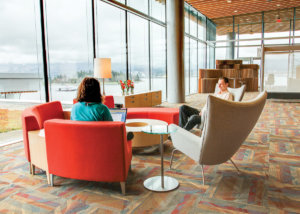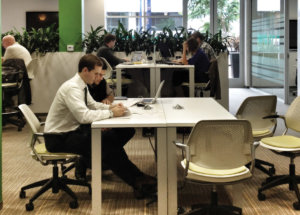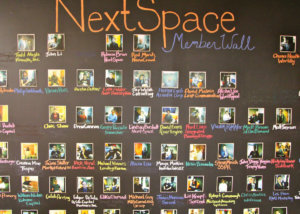Should Your Company Embrace Coworking?
The coworking movement developed to provide community and a collaborative working environment for independent and remote workers. It’s a trend some established companies are learning from.
Advances in technology have made it possible for many white-collar knowledge workers to do their jobs from virtually anywhere. But anywhere still means somewhere, and finding the right place is not always easy.
Some people try working out of a home office but end up feeling too lonely. Others experiment with coffee shops or hotel lobbies but find too many distractions. Now many people are turning toward coworking spaces — shared open office facilities where they hope to find the right balance of community and autonomy.
To understand the reasons for the popularity of this new way of working, our research team visited and interviewed community leaders or founders of two dozen coworking spaces around the United States. One team member also spent six months as a member of a space. We also garnered a broader and more representative perspective on coworking by analyzing the descriptions of a sample of more than 200 coworking spaces in the United States and Europe that were listed in an online directory of coworking facilities. In addition, we interviewed more than 30 people who belong to coworking spaces. These encounters gave us an insiders’ perspective on the experience of coworking and the challenges and opportunities of running coworking spaces.
Besides gaining insights into how people are using these new spaces to work and create new kinds of professional communities, we learned that some large, traditional companies are adopting certain aspects of coworking as part of their overall workplace strategies. Three trends in particular stood out.
1. Companies see sharing space as a way to tap into new ideas.
One of the key benefits cited by people using coworking spaces is the opportunity for serendipitous encounters with people from outside their own team or organization. This is part of the reason the office furniture manufacturer Steelcase participates in a coworking hub in Grand Rapids, Michigan called GRid70 that brings Steelcase’s workers together with employees from other large companies in the area — including Amway, Meijer, and Wolverine Worldwide. Each company has a dedicated space at GRid70, but all share the reception area, open workspaces, conference rooms, and kitchen facilities. “Our belief is that mixing creative teams from different industries will spawn ‘happy accidents’ that inspire innovation, new products, and different ways of thinking,” one Steelcase executive explained.
In some organizations where employees spend much of their time traveling, high levels of mobility mean creating a workplace that is more like a service hub or drop-in center (not unlike a coworking space).
Interestingly, individuals who join coworking spaces tend to do it for similar reasons as Steelcase had for participating in GRid70: to make it easier to meet new people. A survey we conducted of more than 200 U.S. coworkers confirms that the most common reasons people seek out a coworking space have to do with belonging to a community: chances for (1) interaction with people (84%), (2) random discoveries and opportunities (82%), and (3) knowledge sharing (77%).
The most successful coworking spaces we have visited are the ones that cultivate a sense of community among members. Liz Elam, founder of Link Coworking in Austin, Texas, told us that one of the success factors for many coworking spaces is their use of a community manager to facilitate connections among members; such connections build trust, rapport, and collegiality within the space.
Often the members of coworking spaces are individuals working on similar projects in the same industry, launching startups, or working remotely for different companies, and they see the chance to come into contact with peers from different organizations as a benefit. They typically establish community rules and norms for themselves. Members sometimes even have a say in who gets to be a part of the community.
Some companies, including Zappos, State Farm, Sprint, Google, SAP, and Quicken Loans have created coworking-like spaces to be used by employees and others in their communities. For some of these organizations, running a coworking space offers an opportunity to connect with local talent and broaden their
innovation pipeline by providing them with a line of sight to local innovation and entrepreneurial networks.
Some coworking spaces are specifically designed to accommodate the needs of corporate employees or those for whom corporate workplace standards and regulatory compliance are especially important. For such workers, areas zoned for confidential work and individually assigned spaces are preferable. Serendipity Labs — a growing chain of urban and suburban spaces — positions itself as an environment that offers a blend of hospitality, coworking, and shared offices. Its members range from remote workers for large organizations such as PepsiCo and GE Healthcare to independent professionals and small teams.
2. Employees value the flexibility and autonomy of coworking.
More employees are choosing to forgo long commutes by working remotely and by scheduling their work in the way that makes them most productive. Plantronics Inc., an audio communications products and solutions company, gives employees of its headquarters, in Santa Cruz, California, the choice of whether to commute to the headquarters office, work from home, or join one of nine branches of NextSpace coworking. Co-Merge, a San Diego-based coworking space, has witnessed an increase in members who work remotely for a variety of area employers. As Michael Kenny, managing partner of Co-Merge, told us, “We have users from global companies such as Accenture, Groupon, and Citrix Systems, and more and more companies with several hundred to several thousand employees who use the space not only to allow their distributed workers to get productive work done but also to attract employees who demand a flexible workplace and work time.”
Autonomy is another key selling point of coworking. “I love waking up in the morning and knowing that I’m in charge of where I’m working that day,” says Alex Hillman, founder and active member of the Indy Hall coworking community in Philadelphia. “Because I don’t have to go into the office, I actually enjoy choosing my workplace based on how I feel and what I need to do that day.”
His statement sums up what we learned from our interviews and visits to various spaces. Coworking members prize flexibility to work in a way that aligns with their individual needs. “Flexible coworking plans allow for people to join coworking spaces in ways that fit their daily and weekly schedule. Many of the people who work in coworking spaces don’t actually work from their coworking space every day, even if they have a full-time spot,” says Hillman. Our survey data supports this statement. On average, respondents indicated spending 56% of their time working from a coworking space over a typical two-week period. They also report spending 29% of their time on average working from home and the balance of their time working from coffee shops, libraries, and traditional offices.
Flexible space design is a prerequisite of many coworking spaces, since the spaces are intended to align with the various work styles of the individuals using them. Coworking spaces typically offer a combination of open space with shared tables, quieter zones to facilitate concentration, enclosed spaces and “phone rooms” for privacy or confidential work, lounge areas with couches, and conference rooms to be used as needed. So even if members decide to work in the coworking space each day, the specific place they work can vary from day to day and throughout the day.
In addition to spatial flexibility, many coworking spaces offer temporal flexibility by often allowing members to access the space 24/7, so they can work at whatever time fits their desired schedule. In talking with members of coworking spaces, one of the most valued differences between coworking and working in a traditional office was the feeling that members could have scheduling flexibility without feeling judged by their fellow coworking space members. In these communities, work schedules are expected to be variable, and there is no pressure from other members to conform to a regular nine-to-five routine.
3. Coworking can reduce real estate costs and provide employees with more workspace options.
One reason companies like coworking is because it can lower their real estate costs and provide greater flexibility in procuring space. On the whole, coworking tends to be cheaper for companies than opening dedicated office space in certain markets with a large percentage of highly mobile employees.
As the structure of work becomes less fixed to a particular time and place, the traditional corporate real estate model of assigning all employees to particular spaces and assigned desks in a single building is being seen as an unproductive investment. Our experience in the study of space utilization in organizations indicates that, at any given time, a substantial fraction of workspace in a typical corporate office setting is empty and not being utilized. Much of this underutilization of space is indicative of workers’ inherent mobility — going to and from meetings throughout the office or outside of the office.
In some organizations where employees spend much of their time traveling, high levels of mobility mean creating a workplace that is more like a service hub or a drop-in center (not unlike a coworking space) in cities where employees are likely to cluster at various points in time. Coworking spaces, meanwhile, provide companies with even greater flexibility for teams or individuals, since space is available without the need for a lease or any long-term commitment.
When corporate real estate leaders require a platform for providing a choice of flexible workplace options to individuals or teams, they can turn to organizations such as ShareDesk or LiquidSpace. ShareDesk and LiquidSpace enable companies to rent out unused desks or conference rooms to boost revenue, increase their own utilization of space, and create the feel of a coworking space within their own organizations. And while opportunities for collaboration are a major reason for encouraging people to work from coworking spaces, there are newer platforms like Breather that market spaces to individuals or teams that are designed for more quiet and focused work.
Ready or not, the old-style office is fading fast. Now that the structure of work is becoming less tied to a particular time and place, the traditional corporate real estate model of assigning all employees to a fixed space in a single building or on a single campus is rapidly becoming outdated. Given employee demand and the possibility of both a creative dividend and cost savings for companies, various kinds of coworking solutions seem likely to prosper.



